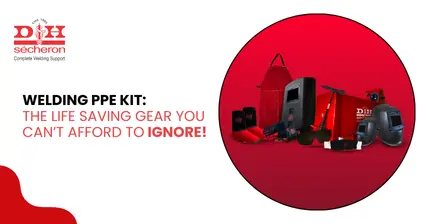The A to Z of Butt Weld Joint
In the world of welding, there are many ways in which a weld joint is classified. Some of these are the T-joint, corner joint, edge joint, cruciform joint, and lap joint. But the most common one is a Butt Weld Joint, and this blog compiles all the information about it.
What is a Butt Weld Joint?
A Butt Weld Joint is formed when the two parts of the metal to be welded are placed end-to-end on the same plane. The Butt Weld Joint is the simplest and hence the most versatile to achieve different results as per the project at hand. It is used widely in piping systems, automotive, energy, and power industries.
Types of Butt Welds
Butt Weld Joints are made in many ways. These types of welds are chosen depending on the project's nature and the metal's thickness. What makes each of them different is the type of groove. The groove is a root opening or a gap between the two parent metals. Here are the most common types of butt welds:
-
V grooves: Single and double
-
J grooves: Single and double
-
U grooves: Single and double
-
Bevel: Single and double
-
Square, and so on.
Preparation of the Butt Weld Joint
The butt weld joint metal’s surface which melts during the process is called the faying surface. Often, these are shaped before being welded. This is done in order to increase the weld’s strength. This process is called edge preparation. Edge preparation may be different or the same on both sides of the joint. Edge Preparation, along with increased strength, provides deeper weld penetration and a smoother appearance of the weld.
Once edge preparation is done, the butt weld joint can be welded using different forms of welding. This can be resistance welding or high-energy beam welding. However, it performs the best with the common arc welding types: TIG welding, and MIG welding.
The butt weld filler material and the welding consumables are determined by the form of welding chosen by the welder.
D&H Sécheron provides expert solutions for all your welding needs. You can check out butt weld joints, both conventional and reclamation welding consumables on our website.
Advantages of Butt Welds
-
It is the easiest to inspect.
-
It has high strength with complete fusion of the butt weld filler material.
-
It is applicable to a wide variety of metals.
-
It is easy to treat after welding. This is for processes like grinding, polishing, painting, and other machine work.
-
It has lesser distortion post-welding.
-
The pipe welding done for butt weld joints is cost-effective.
Disadvantages of Butt Welds
-
It has limited applications owing to the geometry of welding.
-
It might be prone to porosity or cracking.
-
It might require additional fixturing or backing.
-
Burn-through and incomplete penetration are other challenges it may have.
-
It is sensitive to the faying surface conditions.
We have now covered the A to Z of Butt Weld Joints. The next time you see a butt joint, pick up your welding consumables from D&H Sécheron and start your project with the right welding support.
11 May 2025 | Welding
An In-Depth Exploration of Low-Alloy Steel: Your Comprehensive Guide
11 May 2025 | Welding
Nagpur - Bori - Tuljapur Road MSH-3 in Yavatmal District (Maharashtra)
11 May 2025 | Welding
Guidelines to Understand Gas Welding: Applications, Advantages & Disadvantages
11 May 2025 | Welding
3 Tips for Finding the Best Mild Steel Electrode for Your Application
11 May 2025 | Welding
How to Select the Right Welding Filler Wires for Stainless Steel Welding?
11 May 2025 | Welding
Building the Narendra Modi Stadium with Norma V and Autotherme-1 Electrodes
11 May 2025 | Welding
Low Alloy Steel Welding in a (PEB) Pre Engineered Building Structure
11 May 2025 | Welding
Welding Rods: Different Types and Tips for Properly Storing and Handling
11 May 2025 | Welding
Tips for Flawless Welds with Stainless Steel Electrodes: Pros and Cons
11 May 2025 | Welding
Exploring Applications and Benefits of Stainless Steel Welding Electrodes
11 May 2025 | Welding
Welding Basics: Joining Metals with Heat and Pressure - A Beginners Guide
11 May 2025 | Welding
Distinguishing Low-Alloy Steel from High-Alloy Steel: Understanding the Variations
11 May 2025 | Welding
Hard Facing Wire - Understanding the Process and Achieving Optimal Result
11 May 2025 | Welding
Exploring the Advantages of Stainless Steel Electrodes in Welding Applications
11 May 2025 | Welding
Weathering Steel vs. Traditional Steel: A Comparative Analysis of Performance
11 May 2025 | Welding
Choosing the Right Welding Rod: Why 6013 Electrodes Might Be Your Ideal Option
11 May 2025 | Welding
Why 7018 Electrodes Are Preferred for High-Strength Welds in Pipeline Construction
11 May 2025 | Welding
Filler Wire vs. Stainless Steel Filler Wire: Understanding the Key Differences
11 May 2025 | Welding
Exploring the Impact of Filler Material on Welding Quality and Durability
11 May 2025 | Welding
Choosing the Right Cast Iron Electrode for Different Welding Projects
11 May 2025 | Welding
Top Advantages of Cast Iron Electrodes for Industrial Welding Applications
11 May 2025 | Welding
Key Benefits and Challenges of Using TIG Welding in Industrial Projects
11 May 2025 | Welding
5 Reasons Why 7018 Electrode is the Gold Standard for Welding Professionals
11 May 2025 | Welding
Top 5 Advantages of Flux Cored Arc Welding for Heavy-Duty Applications.png)
11 May 2025 | Welding
Lotherme-601: A Game-Changer for Restoring Shoulder Pins in Heavy Machinery
11 May 2025 | Welding
How D&H Sécheron Helped Repair a Rotary Kiln’s Cooler Section with LoTherme 352
11 May 2025 | Welding
Piston Repair for Mining Industry: Cost-Effective Solutions with LoTherme 468.webp)

.jpg)





.jpg)








































.jpg)
.jpg)

.jpg)

.jpg)





.jpg)
.jpg)



.webp)
.jpg)
.jpg)
.webp)
.jpg)






















.png)



.webp)

.webp)
.webp)



